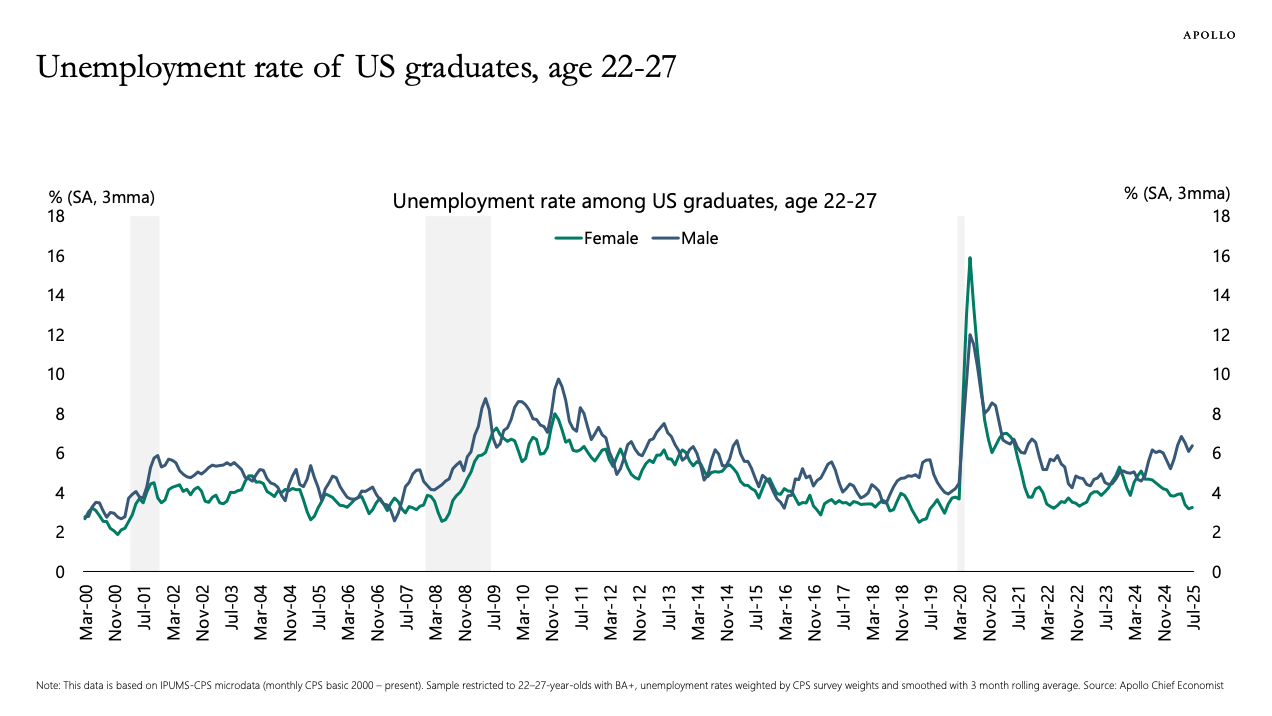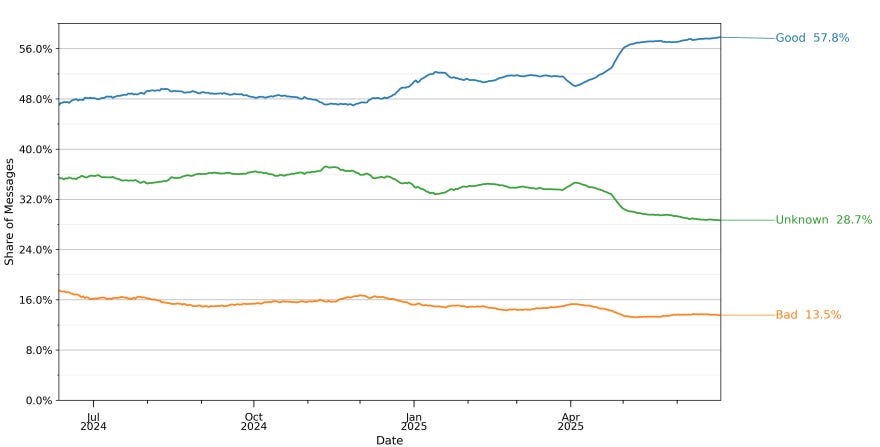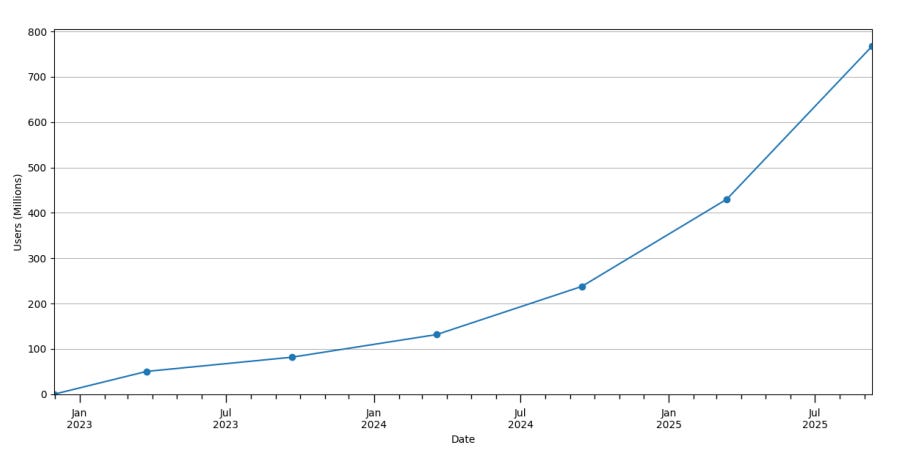Maybe the stock market is nuts
And: How humans use AI
Welcome to Cautious Optimism, a newsletter on tech, business, and power.
📈 Trending Up: Splitting the atom … the Shipping Container theory of AI ... cybersecurity … investment in Hangzhou … age verification …
📉 Trending Down: Quarterly reports? … the TikTok ban … fake apologies … economic growth in China … the far-right in the UK … European security …
Time to worry
In the wake of the murder of conservative commentator Charlie Kirk (our words on political violence can be found here), agitations on the right for greater control of the nation, and especially speech, have grown louder. Too many to list individually, I want to pull your attention back to network television.
As a refresher: To gain approval for the Paramount-Skydance merger, the combined entity had to pledge to platform more conservative views on CBS News, and appoint an ombudsman to “evaluate complaints of bias.” David Ellison (son of Oracle’s Larry Ellison), said yes and quickly appointed a Trump supporter to the ombudsman role (there was an attempt to scrub the new employee’s online history, but that predictably failed).
A few weeks back, POTUS took a swipe at two network news organizations (ABC and NBC, the two that he has yet to subvert), saying that they should have their licenses revoked by the FCC.
One defanged, two still free. And those under the microscope, while all across the nation — from cabinet secretaries, to university critics, the list goes on — we see calls to punish anyone who did not correctly mourn Kirk. This is not the speech and media landscape of a country building a more robust democracy and non-autocratic government.
Or as Matthew Yglesias put it: “Update on the free speech era: Regime-aligned billionaire bought CBS to install Bari Weiss at the head of the news operation and now the White House wants to shut down the competing networks.”
There are some signs of spine in the Senate, but not enough to limit concern.
Things That Matter
China strikes back on chips: Often lost in the American debate concerning the sale of high-end AI chips to China is what the Chinese Communist Party wants. And it’s for Chinese tech companies to build and use their own chips. After Nvidia got the greenlight to sell its lower-spec H20 chips to the rival nation — so long as it paid its government a 15% vig — China groused that chips from the American company were unsafe to use. Nvidia protested.
Now, China has opened two probes into US chips and US trade policies regarding chips, and claimed today that “Nvidia violated the country’s anti-monopoly law” per CNBC.
Nvidia is stuck in the middle of the mess, trying to sell chips and make money. The mess is, however, a boon for American AI companies which have no dog in the fight, and are buying every advanced GPU they can get their hands on.
Maybe the stock market is nuts: Have you checked your investment accounts lately? Numbers seem a bit high? Worried that the stock market is a bit overheated? You might be right. Tesla’s CEO just bought $1 billion worth of company shares. The result? A 7% rally worth tens of billions of dollars.
Gemini, the recently public crypto trading firm, is another example. With just $67.9 million worth of H1 2025 revenue (down from $73.5 million in H1 2024!), the company is now worth $3.8 billion. If you annualize its H1 run rate, Gemini is trading at 28x revenues. That’s insane for an unprofitable, shrinking company. And yet.
I don’t know how long the market can trade on vibes, or sugar-hits from future OpenAI spending commitments. At the same time, the market can always stay irrational longer than any single trader can stay solvent. So, on we buy into our index funds, hoping for the best.
Well, would you look at that: Recently, the CEO of xAI sued Apple, arguing that the company had tilted its App Store against OpenAI competitors (and in a tweet that “ is behaving in a manner that makes it impossible for any AI company besides OpenAI to reach #1 in the App Store”).
Over the weekend, Google’s Gemini AI app soared to the top of the charts. Why? Because users love its new nano-banana visual model. It can do much of what people have traditionally used Photoshop for, quickly and cheaply. Users love it. So, the app has surpassed ChatGPT (now ranked second).
At present, X is ranked eighth here in the United States, and Grok 79th.
What’s weird about the Apple complaint is that when xAI makes great models, people use them. The company’s Grok Code Fast 1 has soared on some usage tables, making xAI the most popular model maker over on OpenRouter. Why complain when things are going well?
Chart of the Day
From Apollo’s Chief Economist Torsten Sløk, the following:
Female unemployment shot higher during peak COVID unemployment, but since then, we’ve seen young adult female employment rates perform better than among men. As you can see from the last few quarters, a gap is forming, indicating that women are seeing greater employment prospects lately than men. Tracking how industries are staffing (healthcare up, tech down) and crossing those with the gender breakdown of their workforce (healthcare is majority female, tech majority male) implied what the chart shows.
Part of the reason behind the divergence, of course, is that more women than men today earn college degrees, which are prerequisites for many employment types.
How humans use AI
The two largest AI labs in the United States, OpenAI and Anthropic, dropped usage data for their services today, providing a fascinating look into just how regular folks are using their services.
The data indicates that while we may group major AI model makers under a single banner, they are more differentiated than we credit them to be.
Anthropic’s data, tracking changing usage patterns over an eight-month period, found that more than a third (36%) of its usage comes from users employing its Claude AI model for coding help, “educational tasks surged from 9.3% to 12.4%, and scientific tasks from 6.3% to 7.2%” of its dataset.
Anthropic also found that users are directing Claude to do something for them more often, with conversations in which “users delegate complete tasks to Claude, jumped from 27% to 39%.” Perhaps 2025 really is the year of the agent?
Anthropic also found that wealthy nations user more AI. Canada and Singapore were called out by name as nations with usage that far outstrips “what would be expected based on their population.” Finally, usage varies based on geography even inside of nations. Anthropic sees “elevated use [of Claude] for IT in California,” while folks in Florida use it for financial work.
What does OpenAI add to the convo? Looking at conversations from the past three years, Sam Altman’s firm reports that the AI gender gap has closed. Back in January of 2024, 37% of its users had “typically feminine names.” By July of 2025, the number was 52%.
Usage of ChatGPT has soared, growing from 451 million daily messages in June of 2024 to 2.63 billion in June of 2025. Over the same timeframe, work-related queries have seen their share of total messages fall from 47% to 27%. Non-work queries rose a complementary 53% to 73%:
OpenAI also reports that ChatGPT’s coding-related queries are low as a share of the whole (4.2%), and that “only 1.9% of ChatGPT messages are on the topic of Relationships and Personal Reflection.”
Similar to Anthropic, OpenAI found a correlation between national wealth and AI usage. Here are two charts that show the spread of AI usage amongst nations from May of 2024 to May of 2025:
This chart is bullish twice. If OpenAI is already at more than 700 million weekly active users of ChatGPT, and it only has a ~third of the higher-income world on its platform and an even smaller share of the less-wealthy world, it has ample room to grow yet.
And there’s reason to expect more growth. Here’s OpenAI’s data on how its users rate its responses:
Which helps explain this chart, showing weekly active ChatGPT users on its various consumer plans:
At some point this final chart will moderate. When you expect that to happen is about when we should expect some of the shine to come off the market.





